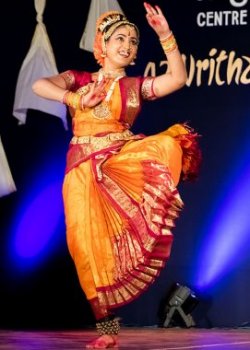
|   |

|   |
Youngsters on song Text & pics: Hareesh N. Nampoothiri e-mail: newn.haree@gmail.com February 19, 2015 Parshwanath Upadhye and Lalitha Sindhuri, two noted young talents in Bharatanatyam and Kuchipudi, performed on Feb 3 and 5 respectively in Thiruvananthapuram. The performances were staged by Regatta Cultural Society as part of their 42nd annual dance and music festival.  A dancer who is pretty vibrant on stage, Parshwanath Upadhye was on his marks from the very first piece itself, a pushpanjali with jatis set by G. Gurumurthy, post-scripted with Lakshmi Nrusimha Karavalamba Stotram. “Sambho Sankara Siva...,” the Sandhya Tandava piece that followed, was even more brisk displaying his virtuosity in making those fast paced footwork, skilled jumps and well balanced body postures. Sancharis were apt, making the bhakti of Ravana and Markandeya easy to discern as Parshwanath gave a glimpse of the stories of the two devotees of Lord Shiva. In ‘Punyah Krishna,’ the viewers got to see an extra agile Krishna on stage. Verses from Adi Shankara’s ‘Krishnashtakam’ (composed by G. Srikanth) formed the lyrics of this piece. The recorded song with a lot of sound mixing and effects was suitable for rehearsed presentation, with limited scope for the dancer to improvise on stage. The dialogue between river Yamuna and the Moon god on the night of Krishna’s birth was something new, followed by the usual leelas of Krishna. Though it started somewhat on the lines of a traditional varnam, half way through, the piece had the dancer’s own customizations. Maybe he could have imagined things better here. Over fantasizing using cartoon kind of sounds and actions hardly added zest to the piece. Rather than having a tranquil face with a tinge of valor after the heroic act of lifting Govardhana, Parshwanath’s Krishna was seen more interested in kind of romancing the gopis! A choreography based on ‘Ardhanareeswara Ashtakam,’ again by Adi Sankara, was the final piece. Being slow paced, with some quick syllables flowing into the stanzas, the composition had its own uniqueness. However, after all that dance in the above pieces, the dancer seemed a bit short of ammo. End of the day, rasikas may be left with an impression of Parshwanath’s acrobatic skills rather than an elevated experience in its entirety, something which the dancer could put some thought into and work on in future. At the end of her recital, the guest for the evening remarked that even being unwell, Lalitha Sindhuri tried to give her best, indirectly answering those wondering souls why her footwork went shaky at times. Even that being the case, Sindhuri managed to move her upper body without showing any sign of tiredness. Flow of hands and clarity of gestures certainly got the attention as she opened with “Sri Ganapathy...” (Tyagaraja / Saurashtra / adi) and followed it with “Anantha Tandavam Ade...” featuring the delightful cosmic dance of Lord Shiva. She could have made these pieces livelier, maybe by bringing some ‘anandam’ from inside for the latter one. Lalitha Sindhuri was seen more confident in the items that followed. Meera bhajan in Darbari Kanada had the heroine praying to her lord to come and alleviate her pain. The stories of Lord Vishnu saving Draupadi, Prahlada and Gajendra were entwined into the piece. Ten incarnations of Vishnu was presented in the Dasavatara Sabdam set to raga Mohanam and misra chapu tala. In “Sarasamu...” (Kapi / adi), a javali by Poochi Srinivasa Iyengar, Lalitha Sindhuri presented a nayika asking her lover to leave as her husband is around. When it comes to parakeeya nayikas, dancers these days often tend to imitate those seductive heroines on screen. Gladly, it was not the case with Lalitha Sindhuri. She handled the sequences remarkably well, suggesting the intentions of the heroine, without those over-exaggerated facial expressions. The musical version of “Jo Achyuthananda, Jo Jo Mukunda...” (Navaroj / khanda chapu), a lullaby by saint-poet Annamacharya, was suited more for listening than to dance. The piece hardly posed any challenge and Sindhuri was seen at ease role-playing the mother and child.  Lalitha Sindhuri
The recital of Lalitha Sindhuri surely had some rough edges here and there. She seemed to be over excited or tensed while introducing the pieces, making her narrations sound amateurish. And while she danced, her footwork sequences often lacked finesse that the rasikas would expect in these stages. Once she takes care of these things, viewers will surely have more reasons to be delighted by her recital. Hareesh N. Nampoothiri is a visual design consultant by profession, an art lover by obsession and a photographer who specializes in dance photography. He writes regularly on classical dance performances and films for various web / print media. He is also an author of three books; director of ‘Thouryathrikam,’ a documentary feature on Kathakali and the founder of NEWNMEDIA™, a firm providing digital design solutions. |